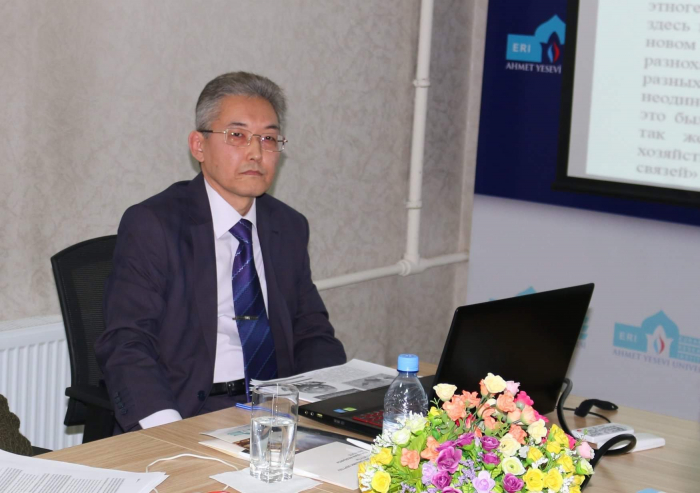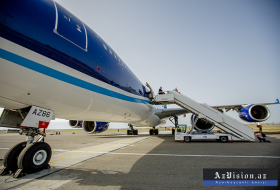AzVision.az interviewed Yerkin Baidarov, Kazakhstani political scientist, and leading researcher at Ramazan Suleimenov Institute of Oriental Studies under the Science Committee of the Ministry of Education and Science of the Republic of Kazakhstan.
- What is the contribution of the Turkic peoples to world history?
‘The Turkic countries and peoples have made an invaluable contribution to global history since over the past two thousand years they have penned a tremendous amount of spiritual and material achievements in the history and culture of mankind (religion, philosophy, culture, metallurgy, domestication, military art, diplomacy, trade, science, architecture, etc.). The Turkic people have a glorious history, which has been side-lined into the backyards of world civilization due to Eurocentric approaches. We finally have the opportunity to objectively analyse history to identify the proper place and role of the Turkic peoples. For example, if we start recording the contributions of the Turkic peoples to world history from Anacharsis (7th-6th centuries BC) – a Scythian philosopher – (modern-day paleogenetic studies categorize the Scythians as Turkic speakers), who was one of the Seven Sages of Greece, we clearly see that the Turks have been ‘present’ for almost three thousand years.
The Turkic peoples still contribute to various fields of human life. Orhan Pamuk, a celebrated Turkish writer, won the Nobel Prize in literature in 2006 and in 2015 Nobel prize in Chemistry was awarded to Professor Aziz Sancar for his mechanistic studies of DNA repair. The entire world knows of Uzeyir Hajibeyov, Nazim Hikmet, Mukhtar Auezov, Chingiz Aitmatov and others. The Kazakh singer Dimas Kudaibergen burst into the Western world, introducing the Kazakh – and the Turkic as a whole – culture.
Having arisen in the steppes of central Eurasia, the Turkic world has become an integral part of the political history of all mankind and their contribution to world history has been as great as that of Chinese, Indian, European, and other civilizations. However, the Turkic contribution is often dissolved in the concept of the Arab-Islamic civilization. This is a methodological inaccuracy that defines the cultural and civilizational contribution only through religious affiliation. In fact, the Turkic component within the Arab-Islamic culture stands out as quite original and self-sufficient. Therefore, we should discuss the Turkic culture and civilization as a separate concept.’
- How did the 13th-15th century Mongol campaigns and conquests influence the socioeconomic and cultural life of the Turkic peoples?
‘The 13th century Mongol campaigns led by Genghis Khan and the descendants of his ‘golden family’ cast countless disasters on the peoples of Central and South Asia, Near and Middle Eastern countries, destroying the socio-economic and cultural life of the Turkic peoples, bringing their further development to a halt. Many cities that lay on the Great Silk Road had been left in ruins. Many Turkic tribes, who refused to serve the ‘Shaker of the Universe’, were subjected to destruction, while those, who survived, fled to Eastern Europe and the Middle East.
As the Turkic Khaganates (9th-10th centuries) fell, the Turkic states of the 10th through 13th centuries (Karakhan Empire, Gaznavi Empire, Anushtegin Dynasty, Seljuk Empire, Volga Bulgaria) and the Turkic civilization as a whole, which stretched from the Yellow Sea in the East to the Mediterranean Sea on the West, from Volga in the North to Ganges in the South, were living their heyday. Fairness would oblige me to note that the Turkic culture of the time flourished under the great influence of Persian culture, be it architecture or poetry. Science (history, geography, medicine) was significantly affected by Arabic and later Persian languages. Nevertheless, I can cite many a name of Turkic origin (or those of different descent, but created in Turkic), whose works are among the spiritual treasury of mankind. These are Al-Farabi, Al-Jawhari, Balasaguni, Al-Kashgari, Ahmad Yasawi, Sulaimon Boqirghonii and many others.
One might say that the socio-economic and cultural life of the Turkic peoples of the time was going through the Turkic Renaissance, discontinued by the Mongol invasion. Only one and a half centuries later, as the Mongols dissolved into the ‘sea’ of Turkic peoples where they could achieve nothing (Anatolia / Asia Minor), do we see an intellectual revival of the Turks throughout the lands I contoured above. Most of the tribes that arrived with Genghis Khan from the Mongolian steppes had by that time adopted the Turkic language, culture, and worldview, thus going through a synthesis of related Turkic-Mongolian tribes with the addition of local traditional patterns (Persian, Indian, etc.) into the ‘fabric’ of their cultures.
The so-called Timurid Renaissance of the 14th-15th centuries in Central Asia is associated with Amir Temur (1336-1405) of Barlas. It was the time, when poets wrote mainly in Turkic languages, such as Hafiz Khwarizmi (author of the Muhabbatnameh poem), Lutfi, Atai, Sakaki and Navoi. Among the Middle East countries, the Azerbaijani poet and visionary Nasimi was also the representative of the time. We can attribute the creations of the great astronomer Ulugbek to the Timurid time as well. When it comes to the post-Timurid age, the historian Mirza Muhammad Haidar Dughlat (author of Tarik-I Rashid – History of Rashid) stands out among others. He is considered the first Kazakh historian in modern-day Kazakhstan and one of the universities in the ancient city of Taraz is named after him.
In Asia Minor (Anatolia) as the last Seljuk Empires reined and the early Ottomans rose, the great star of the Turkish poet and Sufi Yunus Emre broke out. The student of the great Ulugbek, astronomer Ali Qushchi, was created during the reign of the Turkic Sultan Mehmed II. The astronomer came from the Turkic tribe of Qushchi, which once lived in the territory of modern south-eastern Kazakhstan.
This is where I should note that the Mongol army, which conquered Samarkand, Bukhara, Merv, Herat, Baghdad and others, mainly comprised of Turkic tribes, such as the Naimans, Keraites, Kipchaks, and Jalairs. In the Battle of Ain Jalut of 1260 in Palestine, the two armies which came face-to-face were commanded by Turks on both sides – the troops of the Egyptian Mamluks led by the Turks Sultan Qutuz (from the Anushtegin Dynasty) and the future Sultan, Emir Baybars (Kipchak by origin) on one side and the Mongol corps from Hulagu’s army (Genghis Khan’s grandson) commanded by Kit-Bug (Naiman by origin) on the other. We see that the Turks of the time would fight each other, defending the ‘colours’ of their teams, if we are to adopt the modern football jargon.
Therefore, I would like to conclude by saying that the Mongol campaigns of the 13th-15th centuries should be judged comprehensively. They certainly were rather regressive, as they damaged the socio-economic and cultural life of Turkic and other peoples. But on the other hand, these campaigns also had a progressive nature, just as Attila’s campaigns into the Western Roman Empire back in his time. They influenced the formation of centralized states – the Golden Horde, Timur’s Empire, Ottoman Beylik in Asia Minor, which later transformed into the Ottoman Empire, the Jalayirid Sultanate and Aq Qoyunlu State, which were founded on the fragments of the Hulaguids (Ilkhanate), as well as the Crimean, Kazan, Kazakh, and Astrakhan khanates. The socio-economic and cultural life of the Turkic peoples was resurrected during the reign of the latter khanates.’
- Which big events went down in the history of the Turkic world?
‘The historical science in the Turkic world developed unevenly as of the second half of the 19th century and mid-20th century later. While we see a true surge of interest towards the history (Ziya Gökalp and others) of Turks in Turkey after the Tanzimat (period of reform in the Ottoman Empire), history developed to a certain degree in other parts of the Turkic world, under both semi-colonial (Tatars, Bashkirs, Azerbaijanis) and colonial (Kazakhs, Uzbeks, Karakalpaks, the Kyrgyz, Turkmens) dependence. It was mainly driven by the personal initiative of the intelligentsia, who had both an interest and the means to engage in developing this field of science. These were Marcani, Kazembek, Behbudiy, Shakarim, Zeki Velidi and others. History in the Soviet Turkic republics developed in the context of the Marxist theory of class struggle and within the boundaries of shaping ‘Soviet titular nations’, where each Turkic-speaking ‘titular nation’ was proclaimed ‘national in form, socialist in content’. Their history was measured in several centuries only, which cannot even be called history based on the Soviet ideological machine.
Notable rulings of 1940 to 1950 regarding the history of the Turkic peoples in Central Asia left room for local historians to study only the period of colonial dependence on Tsarist Russia and the successes of Turkic peoples achieved under Soviet rule in the history of Turkic nations of the USSR. The rich ancient and medieval history of the Soviet Turkic peoples was practically unstudied in contrast to Turkish and Western scientists. For example, Soviet Kazakhstan banned the works by Shakarim, Tinishpaev, Asfendiyarov, Margulan, Bekmakhanov, Auezov and others, which were devoted to the history and culture of the Kazakh people. Similar works in other soviet Turkic republics alike were also banned.
The science of the history of the Turkic republics went through a true awakening in the 1990s, as the USSR collapsed. Researchers started studying the history of Turkic peoples through new concepts starting from the most ancient times and the Middle Ages through colonial and modern history. Kazakhstan alone published a five-volume ‘History of Kazakhstan’ from 1996 to 2010. We are currently working on publishing the new seven-volume ‘History of Kazakhstan’ and a brief version in English.
Over the past 50 years, a great deal of scientific monographs and articles have been published on Turkic history in the Turkic and the entire world both in English and other languages. The collective monograph ‘The Golden Horde in World History’ was co-published by Kazan Sh. Marjani Institute of History of Tatarstan Academy of Sciences and Oxford University (Russian in 2016, English in 2017) can be considered great achievements of recent years in the historical science of the Turkic world.
Or take a look at another scientific sensation of the discovery of a complex dedicated to Ilterish Kagan (ruler of the Eastern Turkic Khaganate in 682-693) and an inscription in his honour, discovered as a result of an archaeological expedition at Hangai Jote in Mongolia’s Otuken region, conducted jointly by the International Turkic Academy (Astana) and the Institute of History and Archaeology of the Mongolian Academy of Sciences. Ilterish Kagan, who revived the Turkic Khaganate, was the father of Bilge Kagan (ruled from 716 to 734) and Kul Tegin, who also have memorial complexes in the Mongolian steppe. The discovered inscription is the oldest written monument of the Turkic era, which mentions the name ‘Turk’ for the first time. The further publication of this finding will certainly become a great achievement in the development of the historical science of the Turkic world.’
Seymur Mammadov
More about:














































